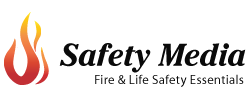Fire Extinguishers

How is a fire extinguisher made?
Is fire extinguisher powder toxic?
Safety Media's Fire Extinguisher Training video online
Fire Extinguishers
A portable fire extinguisher can save lives and property by putting out a small fire or containing it until the fire department arrives; but portable extinguishers have limitations. Because fire grows and spreads so rapidly, the number one priority for residents is to get out safely.
Selecting A Fire Extinguisher
To select the correct type of fire extinguisher, it is important to understand Types of Fires (Class) and Extinguishing Agents. Each class of fire is best fought by a specific extinguishing agent. Extinguishers are rated for the size and class fire that it's designated to fight. For example, an extinguisher with a rating 2A 10BC contains enough extinguish agent to fight 2 square feet of Class A fire or 10 square feet of Class B or C fire. Higher numbers mean more firefighting power.
Extinguishing Agents
Multi-Purpose Dry Chemical
- Non-conductive and can be mildly corrosive
- In order to avoid corrosion it is important to scrub and thoroughly clean up contacted area once fire is out
- Usually used in schools, general offices, hospitals, homes etc.
Wet Chemical
- A new agent that extinguishes the fire by removing the heat and prevents re-ignition by creating a barrier between the oxygen and fuel elements
- Developed for modern, high-efficiency, deep fat fryers in commercial kitchens
- Recommended for all kitchen applications
Regular Dry Chemical
- Non-toxic, non-conductive, non-corrosive
- Easy to clean up, requiring only vacuuming, sweeping or flushing with water
- Usually used in residential kitchens, laboratories, garages, etc.
Carbon Dioxide Gas (CO2)
- Generally these fire extinguishers have a limited range
- Environmentally friendly & leaves no residue, so cleanup is unnecessary
- Usually used in contamination sensitive places like computer rooms, labs, food storage areas, processing plants, etc.
Halotron (Clean Agent) Gas
- Vaporizing liquid that is ozone friendly and leaves no residue, so there is no cleanup
- Ideal for computer rooms, telecommunication areas, theatres, etc.
Safety Tips
- Use a portable fire extinguisher when the fire is confined to a small area, such as a wastebasket, and is not growing; everyone has exited the building; the fire department has been called or is being called; and the room is not filled with smoke.
- To operate a fire extinguisher, remember the word PASS:For the home, select a multi-purpose extinguisher (can be used on all types of home fires) that is large enough to put out a small fire, but not so heavy as to be difficult to handle.
- Pull the pin. Hold the extinguisher with the nozzle pointing away from you, and release the locking mechanism.
- Aim low. Point the extinguisher at the base of the fire.
- Squeeze the lever slowly and evenly.
- Sweep the nozzle from side-to-side.
- Choose a fire extinguisher that carries the label of an independent testing laboratory.
- Read the instructions that come with the fire extinguisher and become familiar with its parts and operation before a fire breaks out. Local fire departments or fire equipment distributors often offer hands-on fire extinguisher trainings.
- Install fire extinguishers close to an exit and keep your back to a clear exit when you use the device so you can make an easy escape if the fire cannot be controlled. If the room fills with smoke, leave immediately.
- Know when to go. Fire extinguishers are one element of a fire response plan, but the primary element is safe escape. Every household should have a home fire escape plan and working smoke alarms.
Source: NFPA
How an Amerex Fire Extinguisher is made - BrandmadeTV
Safety Media is a proud supplier of Amerex fire extinguishers. When you are facing a fire, you don't want your fire extinguisher to fail you because of poor quality manufacturing or materials. Amerex is the gold standard of fire extinguishers.
Is Fire Extinguisher Powder Toxic?
None of the three chemicals most commonly used in dry fire extinguishers is acutely toxic. One component, mono ammonium phosphate, has the potential to cause minor skin irritation and is classed in the same category as acetone.
Most dry fire extinguishers use compressed nitrogen gas to propel a yellow fire-suppressing powder over the flames. This powder is made from sodium bicarbonate, also known as baking soda, a chemical closely related to potassium bicarbonate and mono ammonium phosphate. Of these, only mono ammonium phosphate has the potential to irritate the skin. As of 2014, the National Fire Prevention Association has assigned mono ammonium phosphate a health hazard rating of "1," the lowest level given.
Source: Reference.com
Fire Extinguisher Training
Ensure staff or building occupants know how to operate a fire extinguisher with our instructional YouTube video.
 CAD
CAD
 USD
USD
